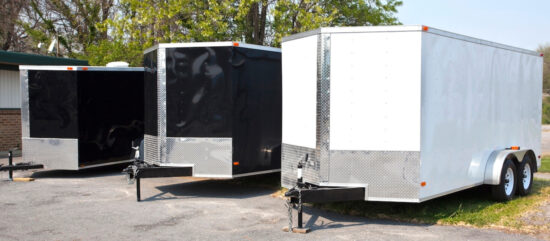Enclosed trailers are a versatile and practical way to transport a variety of cargo, from motorcycles and all-terrain vehicles (ATVs) to various household goods and equipment. Nonetheless, it’s important to remember that towing a trailer safely requires careful planning, preparation, and adherence to safe driving practices.
Selecting The Right Trailer And Towing Vehicle
The first step in safe towing is choosing the right trailer for your needs. Take into consideration the size and weight of your cargo, as well as the type of towing vehicle you’ll be using. The trailer’s towing capacity should exceed the weight of your cargo, and the towing vehicle should have the power and torque to safely handle the additional weight put into it.
There are a lot of enclosed trailer companies that you can look into that offer multiple enclosed trailer models that suit your needs. Make sure that you contact each one to compare each one’s offering to find the best deal.
Ensuring Proper Hitching And Securing
Proper hitching is essential for safe towing. Make sure the trailer hitch is the correct size and type for your trailer and towing vehicle. The hitch ball should be the correct size for the hitch receiver, and the hitch pin should be properly secured.
Once the trailer is hitched, secure the trailer’s safety chains to the towing vehicle. The safety chains should be crossed and have enough slack to allow for articulation but not so much that they can drag on the ground.
Loading And Balancing The Trailer
Distribute the weight of your cargo evenly throughout the trailer. Place heavier items towards the front of the trailer and lighter items towards the rear. This will help prevent the trailer from swaying or bouncing.
Secure all cargo with straps, tie-downs, or bungee cords. Make sure the cargo is secure enough to withstand the forces of acceleration, braking, and turning.
If you have fragile cargo, make sure that you place them inside boxes filled with shredded paper and other forms of cargo padding. Never excessively stack boxes on top of each other during transport to avoid any breakage.
Pre-Towing Inspection And Maintenance
Before you start towing, inspect the trailer and towing vehicle for any signs of damage or wear. Check the tires for proper inflation and tread wear. Inspect the brakes, lights, and electrical connections. Carrying out a quick vehicular inspection before embarking on your trip will save you a lot of hassle later on.
Regular maintenance is essential for ensuring the safety of your trailer and towing vehicle. Follow the maker’s recommended maintenance schedule for both the trailer and the towing vehicle.
Safe Driving Practices For Towing
When towing a trailer, it’s important to adjust your driving habits accordingly. Allow for extra following distance and braking time. Be mindful of crosswinds and avoid sudden maneuvers. Finally, always follow all traffic rules, including speed limits, vertical clearances, and the like.
Tips For Handling Trailer Sway
Trailer sway is the phenomenon wherein a trailer moves side to side on their own. It can be a dangerous situation, but it can be prevented by taking the following precautions:
– Reduce Your Speed: The higher the speed, the more likely trailer sway is to occur.
– Avoid Sudden Maneuvers: Abrupt braking or turning can trigger trailer sway.
– Check Tire Pressure: Ensure all tires are properly inflated before traveling to avoid trailer sway.
– Adjust load Distribution: Properly distribute the weight of your cargo to prevent trailer sway from happening.
– Utilize A Sway Control Device: A sway control device can help stabilize the trailer and reduce sway.
Additional Tips For Towing Safety
Use a trailer brake controller. A trailer brake controller allows you to control the brakes on the trailer independently of the towing vehicle’s brakes. This can be helpful in preventing trailer sway and stopping the trailer more quickly in an emergency.
Next, make use of a weight-distributing hitch. A weight-distributing hitch helps to transfer some of the weight of the trailer from the tongue to the towing vehicle’s axles. This can improve handling and reduce trailer sway.
Keep in mind; avoid towing in windy conditions. Wind can make trailer sway more likely. If you must tow in windy conditions, reduce your speed and be extra cautious during driving.
Further, be aware of your surroundings and other vehicles on the road, especially when changing lanes or making turns.
Lastly, take breaks when necessary. Towing a trailer can be tiring. Take breaks every few hours to stretch your legs and rest your eyes.
In Conclusion
Towing a trailer can be a safe and rewarding experience when done correctly. By following the tips and guidelines outlined in this post, you can minimize the risks and ensure that your towing experience is a safe one.



Speak Your Mind